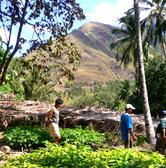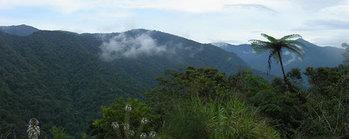Approach
The project Forest and Climate Protection in Panay implemented a holistic nature conservation and development approach, which contributed to the protection of the forest and its biodiversity as well as to the sustainable management of natural resources, to climate protection, biodiversity conservation and to sustainable development on Panay.
The project drew on lessons learned from earlier interventions in order to intensify nature conservation activities, including the protection of critical habitats, forest land use planning, reforestation, sustainable forest management, and the pursuit of agroforestry in the buffer zones. With the participation of local people, forest land use plans were developed, which are, in turn, incorporated into overarching land use plans. This process respects the rights and interests of indigenous groups, while it is at the same time designating critical habitats for endangered species.
The project supported local authorities, user groups and households in applying land rights instruments. It assists them in establishing community forests and in devising management plans for areas of forest designated for conservation and commercial activities. Agroforestry areas were also expanded as the project supported agreements on financing, conservation and rehabilitation. Moreover, the project was involved in carrying out reforestation activities in the buffer zones.
Other working fields were promoting the use of biomass as a renewable energy resource, utilising agricultural waste to generate incomes for local communities, reducing greenhouse gas emissions and encouraging environmental, economic and social sustainability.
To further enhance the protection of forests, climate and biodiversity, the project facilitated the dissemination of relevant knowledge and information, and promoted exchanges of information on these topics among different stakeholders at local, regional, national and international levels.
At the national level, the project supported the Department of Environment and Natural Resources (DENR) in meeting its commitments to the Convention on Biological Diversity (CBD), in particular the CBD’s Strategic Plan 2011-2020. This includes support for effective decentralised conservation measures in the context of the Aichi Target 11 of the CBD.
To keep on developing the results and to mutually reinforce them, the project worked closely together with GIZ’s REDD+ project in the Philippines. Both projects used a joint approach based on the same methods, standards and criteria. The consulting firm DFS Deutsche Forstservice GmbH was also involved in carrying out these activities.
Results
The project provided incentives for sustainable resource management in areas adjacent to the Panay Mountain Range (agroforestry, upland agriculture, and use of bioenergy) for protection of natural forests and rehabilitation of degraded forests, resulting in reduced CO2 emissions of 268,400 tonnes from 2014 to 2017. In addition, flatbed rice dryers heated with rice husks instead of kerosene or electricity also resulted in cost savings for local rice farmers.
The deforestation rate in the Panay Mountain Range was reduced from 3.8 per cent annually before the start of the project to 0.47 per cent in 2017.
Observations of endangered and endemic species such as the Visayan writhed hornbill (Rhabdotorrhinus waldeni) Visayan spotted deer (Rusa alfredi), the Visayan warty pig (Sus cebifrons), the Panay monitor lizard (Varanus mabitang) and Rafflesia plants have increased by 18 per cent.
Forest land use plans for 21 municipalities were developed, resulting in the declaration of 149,118 hectares of protection forest and the designation of 30,049 hectares of habitats of endangered species as protected areas (Critical Habitats).
19,572 hectares of natural forest could be protected through protection agreements with the local population (about 1,500 households) who would receive subsidies for agroforestry and sustainable agriculture in return.
1,143 hectares of degraded natural forest are now rehabilitated or enriched.
1.149 hectares of agroforestry and 452 hectares of sustainable and climate-adapted agriculture areas have been established.
An increase in income from the use of forest land of 36.1 per cent was achieved over a period of three years.
19 environmental offices with sufficient staff and budgets in 19 municipalities contribute to the long-term management and protection of forest resources.
The sustainability of the project is clearly expressed by a statement by the Philippine Environment Minister Roy A. Cimatu “ForClim has proved successful in integrating biodiversity conservation, climate change mitigation and poverty alleviation through sustainable management of forest resources. With the right support from our partner organizations, hopefully we can bring this kind of success to other areas in the country in the near future.”

